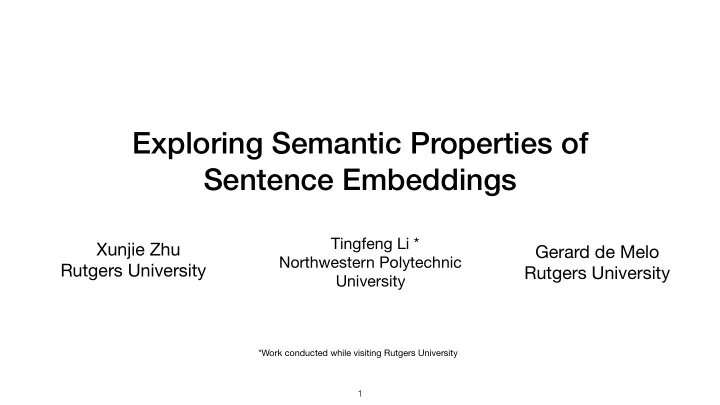

Exploring Semantic Properties of Sentence Embeddings Tingfeng Li * Xunjie Zhu Gerard de Melo Northwestern Polytechnic Rutgers University Rutgers University University *Work conducted while visiting Rutgers University � 1
Introduction • Sentence Embeddings: • Encode a variable-length input sentence into a constant size vector • Examples: • Based on Word Embeddings: (I) Glove Averaging (Wieting et al., 2015) (II) Concatenated P-Mean Embeddings (R¨uckl´e et al. 2018) (III) Sent2Vec (Pagliardini et al. 2018) • Based on RNNs: (I) SkipThought Vectors (Kiros et al. 2015) (II) InferSent (Conneau et al., 2017) Zhu, Li & de Melo. Exploring Semantic Properties of Sentence Embeddings � 2
Goal • Exploring what specific semantic properties are directly reflected by such embeddings. • Focusing on a few select aspects of sentence semantics. • Concurrent related work: Conneau et al. ACL 2018 (i) Their work studies what you can learn to predict using 100,000 training instances (ii) Our goal: Directly study the embeddings (via cosine similarity) Zhu, Li & de Melo. Exploring Semantic Properties of Sentence Embeddings � 3
Approach: Contrastive Sentences Minor alterations of a sentence may lead to notable shifts in meaning. (i) A rabbit is jumping over the fence ( ) S (ii) A rabbit is hopping over the fence ( ) S = (iii) A rabbit is not jumping over the fence ( ) S * Zhu, Li & de Melo. Exploring Semantic Properties of Sentence Embeddings � 4
Sentence Modification Schemes • Not-Negation • Quantifier-Negation • Synonym Substitution • Embedded Clause Extraction • Passivization • Argument Reordering • Fixed Point Inversion Zhu, Li & de Melo. Exploring Semantic Properties of Sentence Embeddings � 5
Negation Detection • Original Sentence: • A person is slicing an onion. • Synonym Substitution: • A person is cutting an onion. • Not Negation: • A person is not slicing an onion. Zhu, Li & de Melo. Exploring Semantic Properties of Sentence Embeddings � 6
Negation Variant • Not Negation: • A man is not standing on his head under water. • Quantifier Negation: • There is no man standing on his head under water. • Original Sentence: • A man is standing on his head under water. Zhu, Li & de Melo. Exploring Semantic Properties of Sentence Embeddings � 7
Clause Relatedness • Original Sentence: • Octel said the purchase was expected. • Extracted Clause: • The purchase was expected. • Not Negation: • Octel said the purchase was not expected Zhu, Li & de Melo. Exploring Semantic Properties of Sentence Embeddings � 8
Argument Sensitivity • Original Sentence: • Francesca teaches Adam to adjust the microphone on his stage • Passivization: • Adam is taught to adjust the microphone on his stage • Argument Reordering: • Adam teaches Francesca to adjust the microphone on his stage Zhu, Li & de Melo. Exploring Semantic Properties of Sentence Embeddings � 9
Fixed Point Reordering • Original Sentence: • A black dog in the snow is jumping o ff the ground and catching a stick. • Synonym Substitution: • A black dog in the snow is leaping o ff the ground and catching a stick. • Fixed Point Inversion(Corrupted Sentence): • In the snow is jumping o ff the ground and catching a stick a black dog. Zhu, Li & de Melo. Exploring Semantic Properties of Sentence Embeddings � 10
Models and Dataset Dataset Embedding Dim # of Sentences From Glove Avg Common Crawl 300 Negation Detection 674 SICK, SNLI P Means Common Crawl 300 Negation Variant 516 SICK, SNLI Penn Treebank Sent2Vec English Wiki 600 Clause Relatedness 567 MSR Paraphrase SkipThought Book Corpus 600 Argument Sensitivity 445 SICK, MS Paraphrase SICK InferSent SNLI 4096 Fixed Point Reordering 623 Zhu, Li & de Melo. Exploring Semantic Properties of Sentence Embeddings � 11
Negation Detection • Average of Word Embeddings is more easier misled by negation. • Both InferSent and SkipThought succeed in distinguishing unnegated sentences from negated ones. 100 75 Accuracy 50 25 0 Glove Avg P Means Sent2Vec SkipThought InferSent Zhu, Li & de Melo. Exploring Semantic Properties of Sentence Embeddings � 12
Negation Variant Both averaging of word embeddings and SkipThought are dismal in terms of the accuracy. InferSent appears to have acquired a better understanding of negation quantifiers, as these are commonplace in many NLI datasets. 90 67.5 45 22.5 0 Glove Avg P Means Sent2Vec SkipThought InferSent Zhu, Li & de Melo. Exploring Semantic Properties of Sentence Embeddings � 13
Clause Relatedness • Both SkipThought vectors and InferSent works poorly when sub clause is much shorter than original one. • Sent2vec best in distinguishing the embedded clause of a sentence from a negation of that sentence. 40 30 20 10 0 Glove Avg P Means Sent2Vec SkipThought InferSent Zhu, Li & de Melo. Exploring Semantic Properties of Sentence Embeddings � 14
Argument Sensitivity • None of the analyzed approaches prove adept at distinguishing the semantic information from structural information in this case. 5 3.75 2.5 1.25 0 Glove Avg P Means Sent2Vec SkipThought InferSent Zhu, Li & de Melo. Exploring Semantic Properties of Sentence Embeddings � 15
Fixed Point Reordering • Methods based on word embeddings do not encode su ffi cient word order information into the sentence embeddings. • SkipThought and InferSent did well when the original sentence and its semantically equivalence share similar structure 100 75 50 25 0 Glove Avg P Means Sent2Vec SkipThought InferSent Zhu, Li & de Melo. Exploring Semantic Properties of Sentence Embeddings � 16
Conclusion • RNN based sentence embeddings better at identifying negation compared with word embedding based models • Both SkipThought and InferSent distinguish negation of a sentence from synonymy. • InferSent better at identifying semantic equivalence regardless of the order of words and copes better with quantifiers. • SkipThoughts is more suitable for tasks in which the semantics of the sentence corresponds to its structure Zhu, Li & de Melo. Exploring Semantic Properties of Sentence Embeddings � 17
Thank you! Questions? Contact us at xunjie.zhu@rutgers.edu and gdm@demelo.org
Recommend
More recommend